warning NISSAN VERSA NOTE 2017 2.G Towing Guide
[x] Cancel search | Manufacturer: NISSAN, Model Year: 2017, Model line: VERSA NOTE, Model: NISSAN VERSA NOTE 2017 2.GPages: 27, PDF Size: 0.56 MB
Page 1 of 27
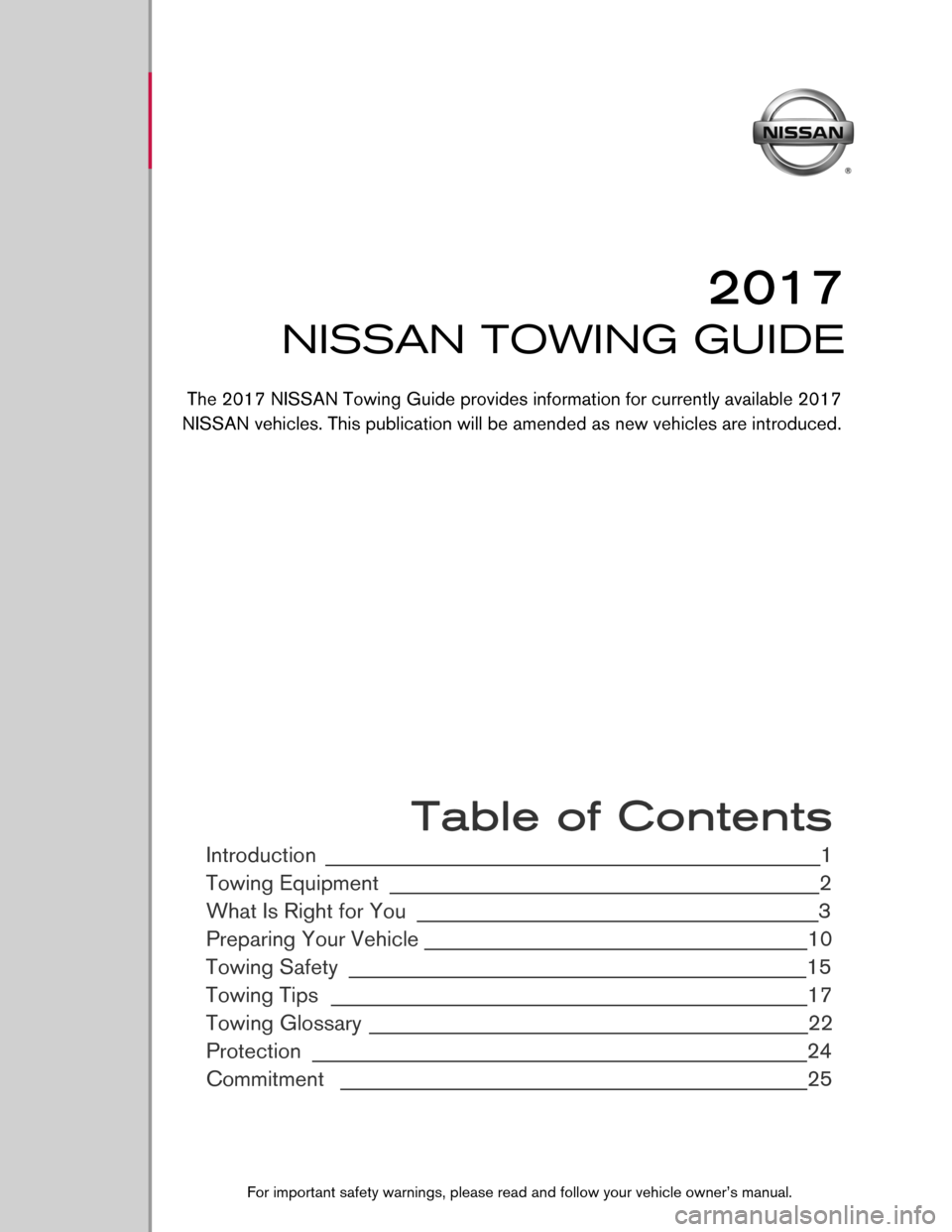
9
2017
NISSAN TOWING GUIDE
Table of Contents
Introduction _____________________________________________________1
Towing Equipment
______________________________________________2
What Is Right for You
___________________________________________3
Preparing Your Vehicle
_________________________________________10
Towing Safety
_________________________________________________15
Towing Tips
___________________________________________________17
Towing Glossary
_______________________________________________22
Protection
_____________________________________________________24
Commitment
__________________________________________________25
The 2017 NISSAN Towing Guide provides information for currently available 2017
NISSAN vehicles. This publication will be amended as new vehicles are introduced.
For important safety warnings, please read and follow your vehicle owner’s manual.
Page 3 of 27
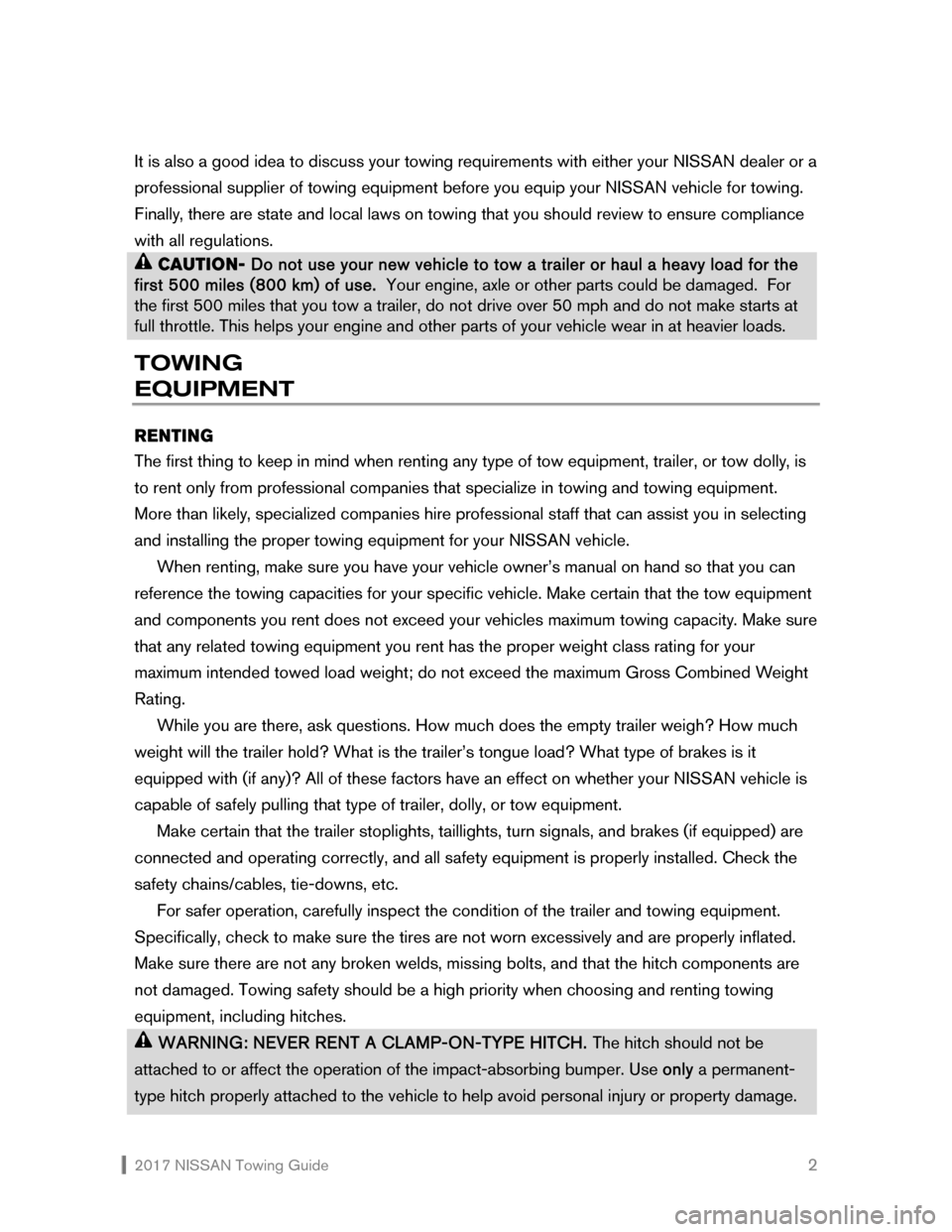
2017 NISSAN Towing Guide 2
It is also a good idea to discuss your towing requirements with either your NISSAN dealer or a
professional supplier of towing equipment before you equip your NISSAN vehicle for towing.
Finally, there are state and local laws on towing that you should review to ensure compliance
with all regulations.
CAUTION- Do not use your new vehicle to tow a trailer or haul a heavy load for the
first 500 miles (800 km) of use. Your engine, axle or other parts could be damaged. For
the first 500 miles that you tow a trailer, do not drive over 50 mph and do not make starts at
full throttle. This helps your engine and other parts of your vehicle wear in at heavier loads.
TOWING
EQUIPMENT
RENTING
The first thing to keep in mind when renting any type of tow equipment, trailer, or tow dolly, is
to rent only from professional companies that specialize in towing and towing equipment.
More than likely, specialized companies hire professional staff that can assist you in selecting
and installing the proper towing equipment for your NISSAN vehicle.
When renting, make sure you have your vehicle owner’s manual on hand so that you can
reference the towing capacities for your specific vehicle. Make certain that the tow equipment
and components you rent does not exceed your vehicles maximum towing capacity. Make sure
that any related towing equipment you rent has the proper weight class rating for your
maximum intended towed load weight; do not exceed the maximum Gross Combined Weight
Rating.
While you are there, ask questions. How much does the empty trailer weigh? How much
weight will the trailer hold? What is the trailer’s tongue load? What type of brakes is it
equipped with (if any)? All of these factors have an effect on whether your NISSAN vehicle is
capable of safely pulling that type of trailer, dolly, or tow equipment.
Make certain that the trailer stoplights, taillights, turn signals, and brakes (if equipped) are
connected and operating correctly, and all safety equipment is properly installed. Check the
safety chains/cables, tie-downs, etc.
For safer operation, carefully inspect the condition of the trailer and towing equipment.
Specifically, check to make sure the tires are not worn excessively and are properly inflated.
Make sure there are not any broken welds, missing bolts, and that the hitch components are
not damaged. Towing safety should be a high priority when choosing and renting towing
equipment, including hitches.
WARNING: NEVER RENT A CLAMP-ON-TYPE HITCH. The hitch should not be
attached to or affect the operation of the impact-absorbing bumper. Use only a permanent-
type hitch properly attached to the vehicle to help avoid personal injury or property damage.
Page 4 of 27
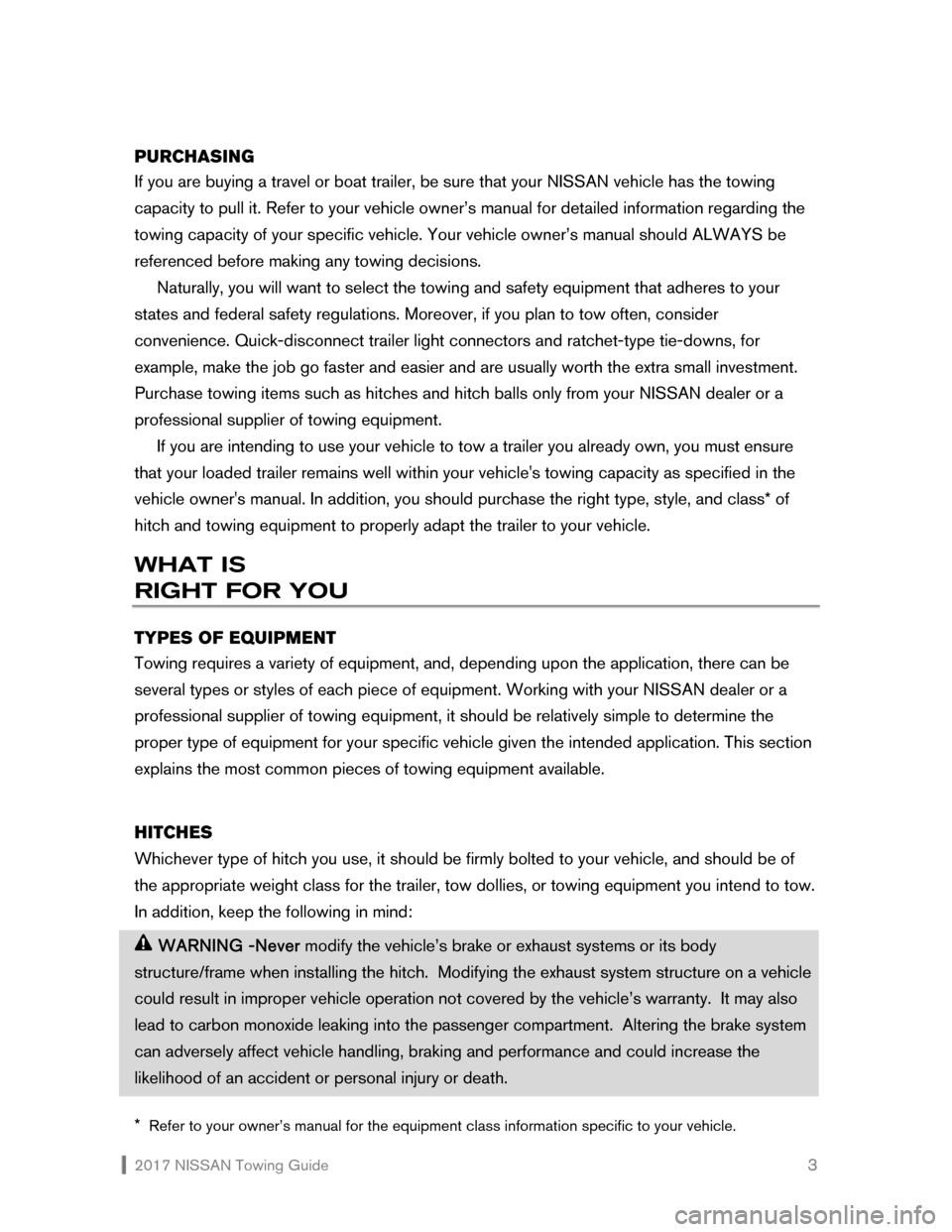
2017 NISSAN Towing Guide 3
PURCHASING
If you are buying a travel or boat trailer, be sure that your NISSAN vehicle has the towing
capacity to pull it. Refer to your vehicle owner’s manual for detailed information regarding the
towing capacity of your specific vehicle. Your vehicle owner’s manual should ALWAYS be
referenced before making any towing decisions.
Naturally, you will want to select the towing and safety equipment that adheres to your
states and federal safety regulations. Moreover, if you plan to tow often, consider
convenience. Quick-disconnect trailer light connectors and ratchet-type tie-downs, for
example, make the job go faster and easier and are usually worth the extra small investment.
Purchase towing items such as hitches and hitch balls only from your NISSAN dealer or a
professional supplier of towing equipment.
If you are intending to use your vehicle to tow a trailer you already own, you must ensure
that your loaded trailer remains well within your vehicle's towing capacity as specified in the
vehicle owner's manual. In addition, you should purchase the right type, style, and class* of
hitch and towing equipment to properly adapt the trailer to your vehicle.
WHAT IS
RIGHT FOR YOU
TYPES OF EQUIPMENT
Towing requires a variety of equipment, and, depending upon the application, there can be
several types or styles of each piece of equipment. Working with your NISSAN dealer or a
professional supplier of towing equipment, it should be relatively simple to determine the
proper type of equipment for your specific vehicle given the intended application. This section
explains the most common pieces of towing equipment available.
HITCHES
Whichever type of hitch you use, it should be firmly bolted to your vehicle, and should be of
the appropriate weight class for the trailer, tow dollies, or towing equipment you intend to tow.
In addition, keep the following in mind:
WARNING -Never modify the vehicle’s brake or exhaust systems or its body
structure/frame when installing the hitch. Modifying the exhaust system structure on a vehicle
could result in improper vehicle operation not covered by the vehicle’s warranty. It may also
lead to carbon monoxide leaking into the passenger compartment. Altering the brake system
can adversely affect vehicle handling, braking and performance and could increase the
likelihood of an accident or personal injury or death.
* Refer to your owner’s manual for the equipment class information specific to your vehicle.
Page 6 of 27
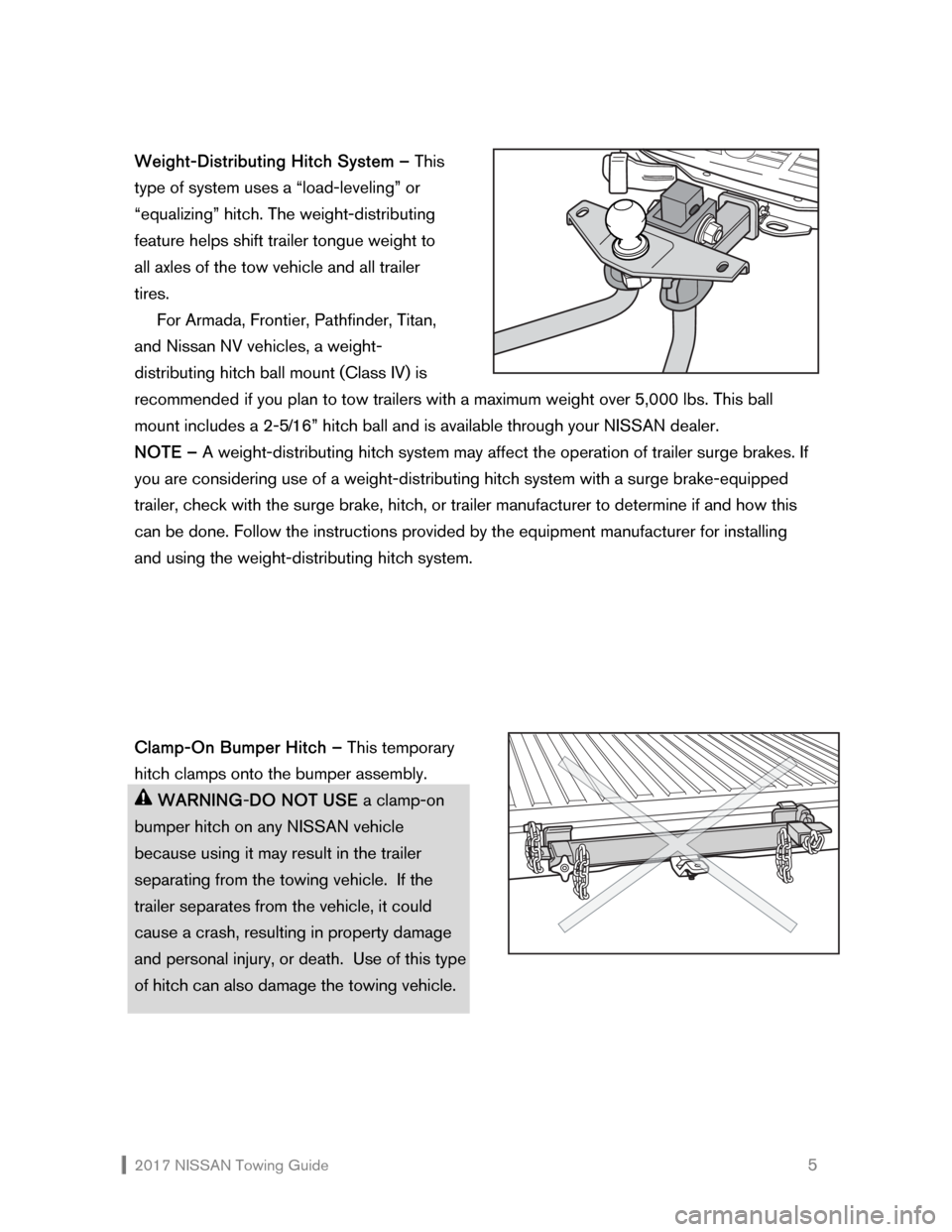
2017 NISSAN Towing Guide 5
Weight-Distributing Hitch System – This
type of system uses a “load-leveling” or
“equalizing” hitch. The weight-distributing
feature helps shift trailer tongue weight to
all axles of the tow vehicle and all trailer
tires.
For Armada, Frontier, Pathfinder, Titan,
and Nissan NV vehicles, a weight-
distributing hitch ball mount (Class IV) is
recommended if you plan to tow trailers with a maximum weight over 5,000 lbs. This ball
mount includes a 2-5/16” hitch ball and is available through your NISSAN dealer.
NOTE – A weight-distributing hitch system may affect the operation of trailer surge brakes. If
you are considering use of a weight-distributing hitch system with a surge brake-equipped
trailer, check with the surge brake, hitch, or trailer manufacturer to determine if and how this
can be done. Follow the instructions provided by the equipment manufacturer for installing
and using the weight-distributing hitch system.
Clamp-On Bumper Hitch – This temporary
hitch clamps onto the bumper assembly.
WARNING-DO NOT USE a clamp-on
bumper hitch on any NISSAN vehicle
because using it may result in the trailer
separating from the towing vehicle. If the
trailer separates from the vehicle, it could
cause a crash, resulting in property damage
and personal injury, or death. Use of this type
of hitch can also damage the towing vehicle.
Page 8 of 27
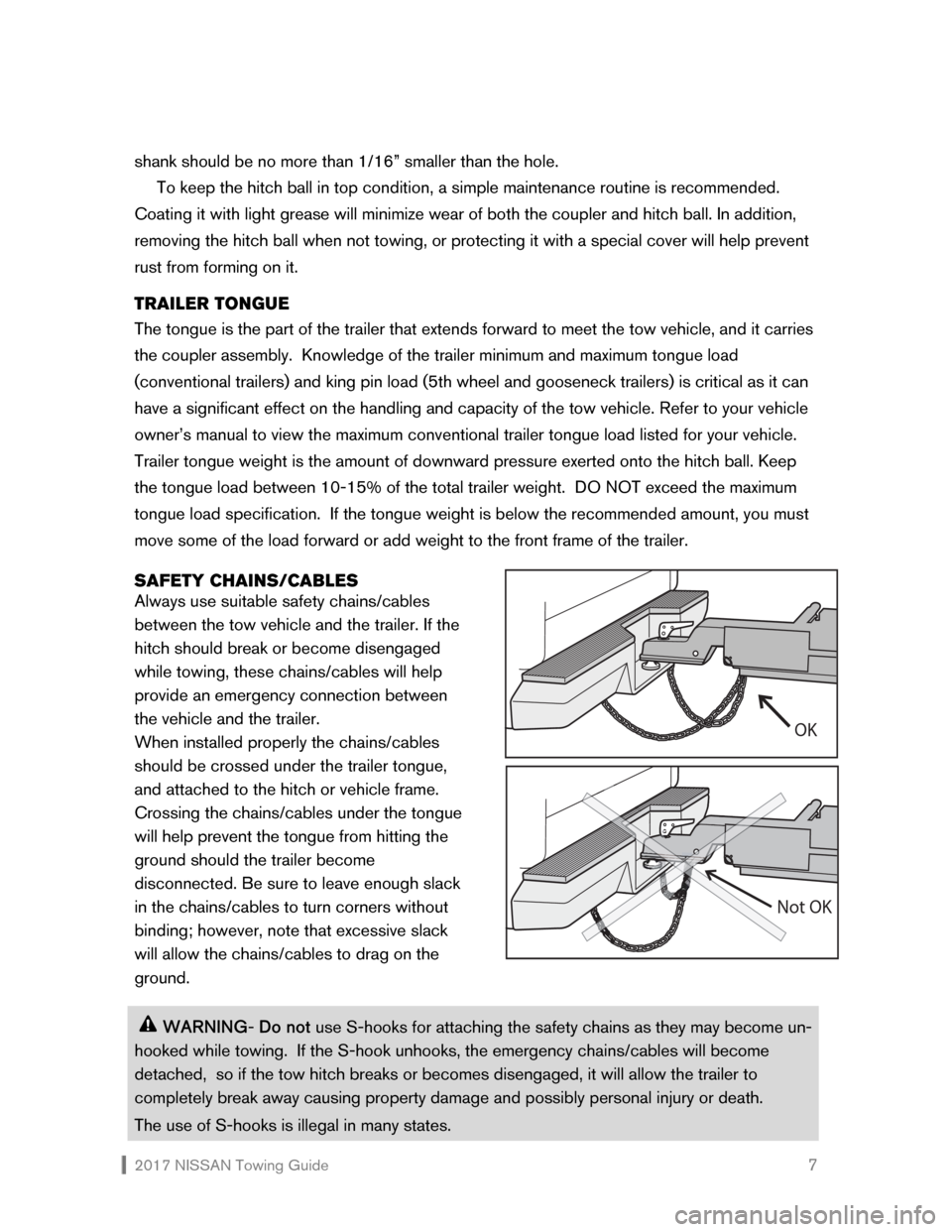
2017 NISSAN Towing Guide 7
shank should be no more than 1/16” smaller than the hole.
To keep the hitch ball in top condition, a simple maintenance routine is recommended.
Coating it with light grease will minimize wear of both the coupler and hitch ball. In addition,
removing the hitch ball when not towing, or protecting it with a special cover will help prevent
rust from forming on it.
TRAILER TONGUE
The tongue is the part of the trailer that extends forward to meet the tow vehicle, and it carries
the coupler assembly. Knowledge of the trailer minimum and maximum tongue load
(conventional trailers) and king pin load (5th wheel and gooseneck trailers) is critical as it can
have a significant effect on the handling and capacity of the tow vehicle. Refer to your vehicle
owner’s manual to view the maximum conventional trailer tongue load listed for your vehicle.
Trailer tongue weight is the amount of downward pressure exerted onto the hitch ball. Keep
the tongue load between 10-15% of the total trailer weight. DO NOT exceed the maximum
tongue load specification. If the tongue weight is below the recommended amount, you must
move some of the load forward or add weight to the front frame of the trailer.
SAFETY CHAINS/CABLES
Always use suitable safety chains/cables
between the tow vehicle and the trailer. If the
hitch should break or become disengaged
while towing, these chains/cables will help
provide an emergency connection between
the vehicle and the trailer.
When installed properly the chains/cables
should be crossed under the trailer tongue,
and attached to the hitch or vehicle frame.
Crossing the chains/cables under the tongue
will help prevent the tongue from hitting the
ground should the trailer become
disconnected. Be sure to leave enough slack
in the chains/cables to turn corners without
binding; however, note that excessive slack
will allow the chains/cables to drag on the
ground.
WARNING- Do not use S-hooks for attaching the safety chains as they may become un-
hooked while towing. If the S-hook unhooks, the emergency chains/cables will become
detached, so if the tow hitch breaks or becomes disengaged, it will allow the trailer to
completely break away causing property damage and possibly personal injury or death.
The use of S-hooks is illegal in many states.
OK
Not OK
Page 9 of 27
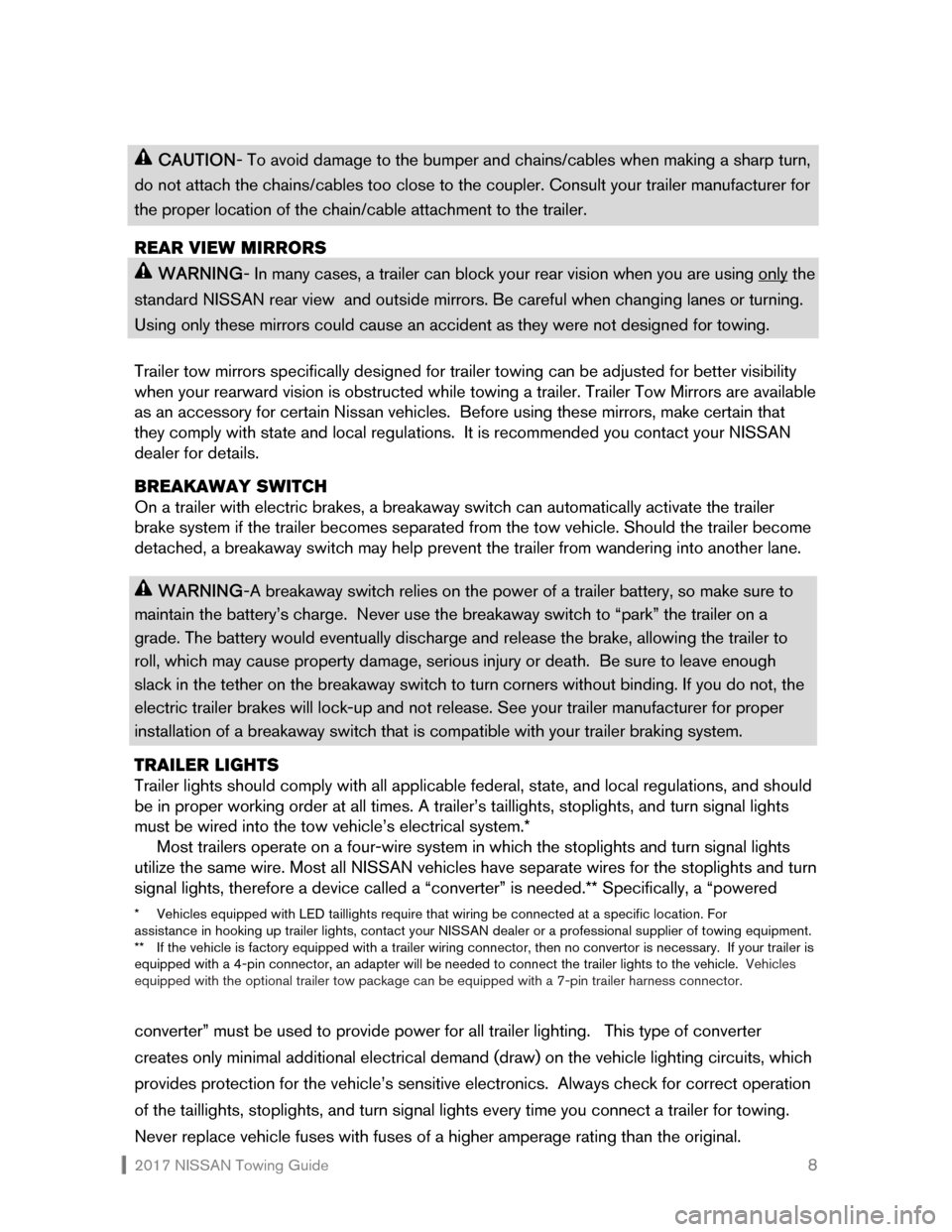
2017 NISSAN Towing Guide 8
CAUTION- To avoid damage to the bumper and chains/cables when making a sharp turn,
do not attach the chains/cables too close to the coupler. Consult your trailer manufacturer for
the proper location of the chain/cable attachment to the trailer.
REAR VIEW MIRRORS
WARNING- In many cases, a trailer can block your rear vision when you are using only the
standard NISSAN rear view and outside mirrors. Be careful when changing lanes or turning.
Using only these mirrors could cause an accident as they were not designed for towing.
Trailer tow mirrors specifically designed for trailer towing can be adjusted for better visibility
when your rearward vision is obstructed while towing a trailer. Trailer Tow Mirrors are available
as an accessory for certain Nissan vehicles. Before using these mirrors, make certain that
they comply with state and local regulations. It is recommended you contact your NISSAN
dealer for details.
BREAKAWAY SWITCH
On a trailer with electric brakes, a breakaway switch can automatically activate the trailer
brake system if the trailer becomes separated from the tow vehicle. Should the trailer become
detached, a breakaway switch may help prevent the trailer from wandering into another lane.
WARNING-A breakaway switch relies on the power of a trailer battery, so make sure to
maintain the battery’s charge. Never use the breakaway switch to “park” the trailer on a
grade. The battery would eventually discharge and release the brake, allowing the trailer to
roll, which may cause property damage, serious injury or death. Be sure to leave enough
slack in the tether on the breakaway switch to turn corners without binding. If you do not, the
electric trailer brakes will lock-up and not release. See your trailer manufacturer for proper
installation of a breakaway switch that is compatible with your trailer braking system.
TRAILER LIGHTS
Trailer lights should comply with all applicable federal, state, and local regulations, and should
be in proper working order at all times. A trailer’s taillights, stoplights, and turn signal lights
must be wired into the tow vehicle’s electrical system.*
Most trailers operate on a four-wire system in which the stoplights and turn signal lights
utilize the same wire. Most all NISSAN vehicles have separate wires for the stoplights and turn
signal lights, therefore a device called a “converter” is needed.** Specifically, a “powered
* Vehicles equipped with LED taillights require that wiring be connected at a specific location. For
assistance in hooking up trailer lights, contact your NISSAN dealer or a professional supplier of towing equipment.
** If the vehicle is factory equipped with a trailer wiring connector, then no convertor is necessary. If your trailer is
equipped with a 4-pin connector, an adapter will be needed to connect the trailer lights to the vehicle. Vehicles
equipped with the optional trailer tow package can be equipped with a 7-pin trailer harness connector.
converter” must be used to provide power for all trailer lighting. This type of converter
creates only minimal additional electrical demand (draw) on the vehicle lighting circuits, which
provides protection for the vehicle’s sensitive electronics. Always check for correct operation
of the taillights, stoplights, and turn signal lights every time you connect a trailer for towing.
Never replace vehicle fuses with fuses of a higher amperage rating than the original.
Page 12 of 27
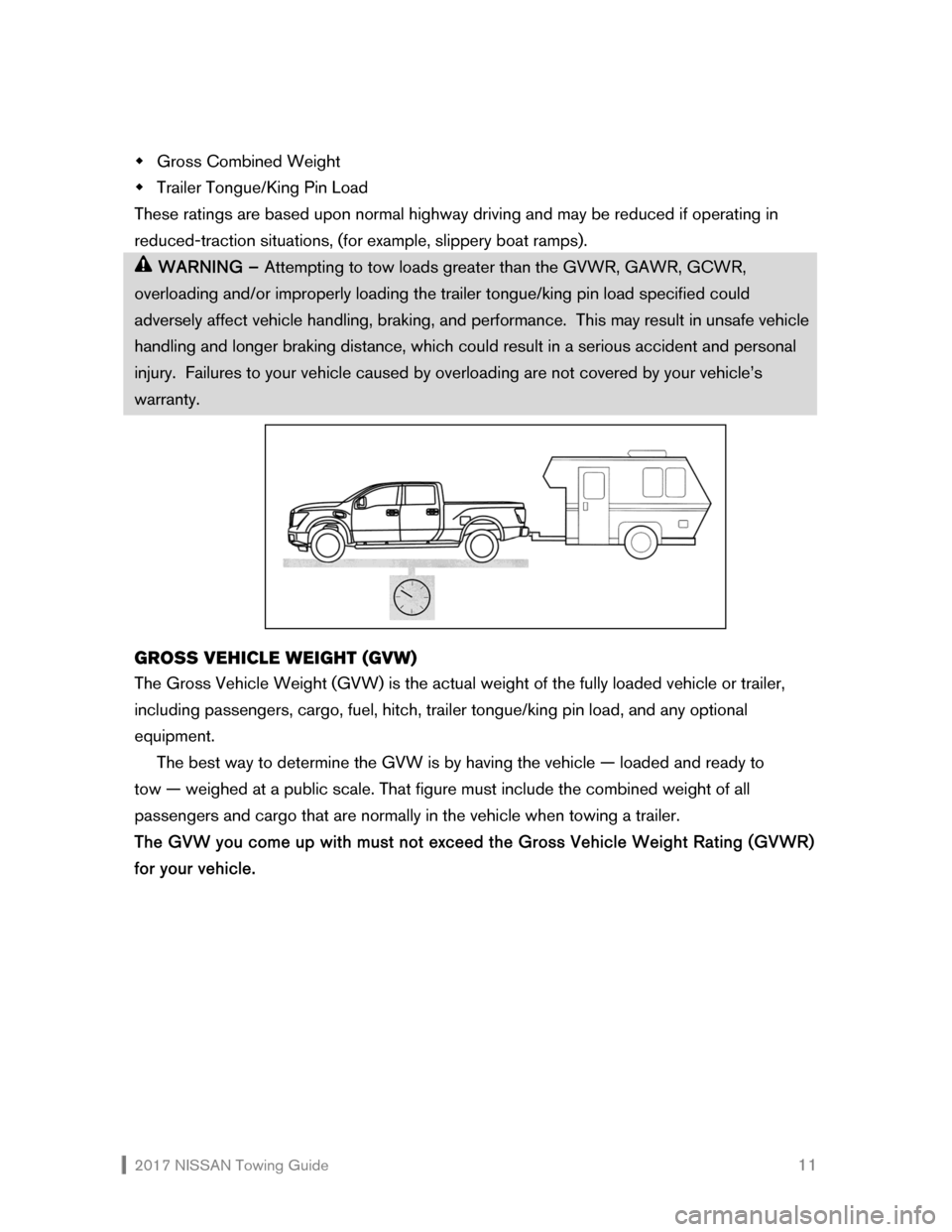
2017 NISSAN Towing Guide 11
Gross Combined Weight
Trailer Tongue/King Pin Load
These ratings are based upon normal highway driving and may be reduced if operating in
reduced-traction situations, (for example, slippery boat ramps).
WARNING – Attempting to tow loads greater than the GVWR, GAWR, GCWR,
overloading and/or improperly loading the trailer tongue/king pin load specified could
adversely affect vehicle handling, braking, and performance. This may result in unsafe vehicle
handling and longer braking distance, which could result in a serious accident and personal
injury. Failures to your vehicle caused by overloading are not covered by your vehicle’s
warranty.
GROSS VEHICLE WEIGHT (GVW)
The Gross Vehicle Weight (GVW) is the actual weight of the fully loaded vehicle or trailer,
including passengers, cargo, fuel, hitch, trailer tongue/king pin load, and any optional
equipment.
The best way to determine the GVW is by having the vehicle — loaded and ready to
tow — weighed at a public scale. That figure must include the combined weight of all
passengers and cargo that are normally in the vehicle when towing a trailer.
The GVW you come up with must not exceed the Gross Vehicle Weight Rating (GVWR)
for your vehicle.
Page 15 of 27
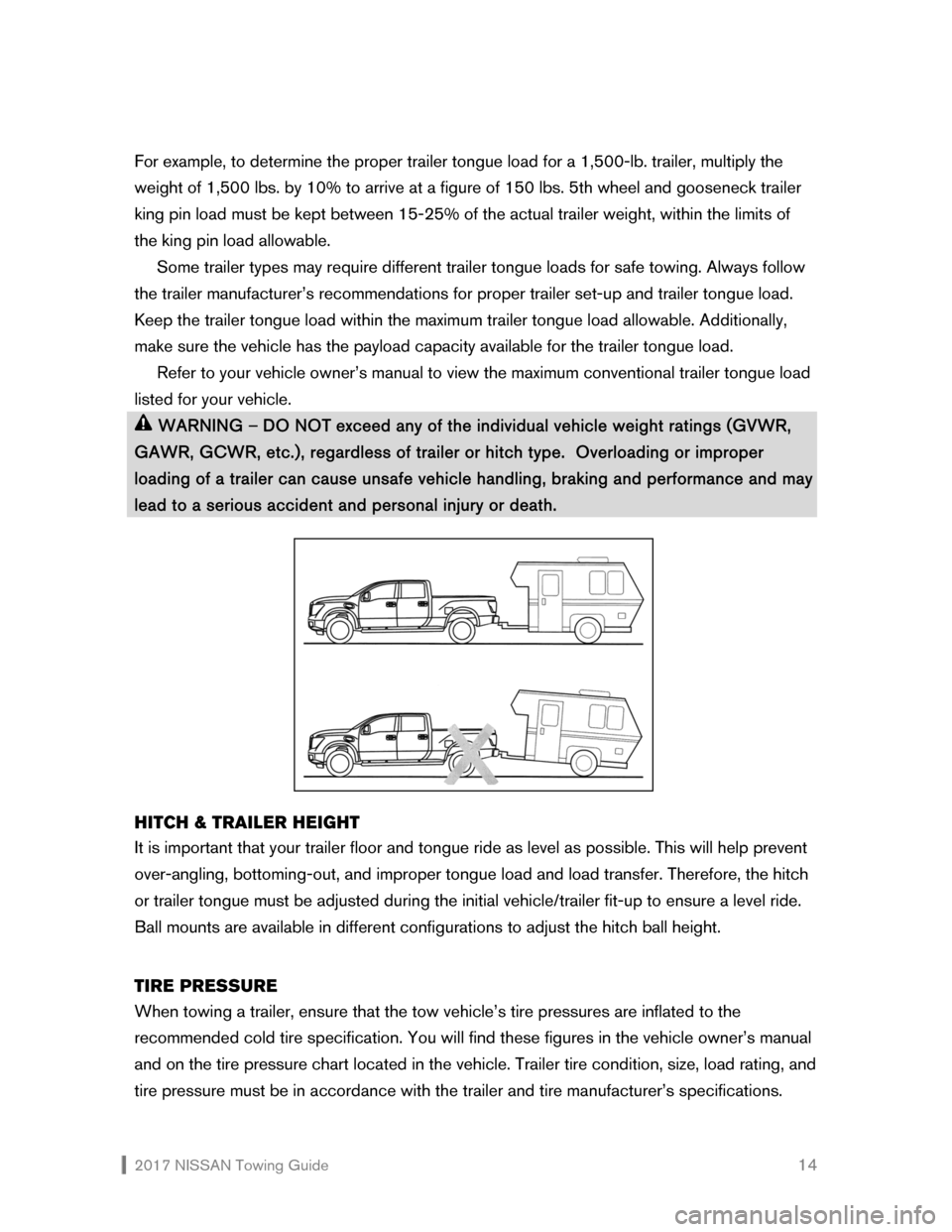
2017 NISSAN Towing Guide 14
For example, to determine the proper trailer tongue load for a 1,500-lb. trailer, multiply the
weight of 1,500 lbs. by 10% to arrive at a figure of 150 lbs. 5th wheel and gooseneck trailer
king pin load must be kept between 15-25% of the actual trailer weight, within the limits of
the king pin load allowable.
Some trailer types may require different trailer tongue loads for safe towing. Always follow
the trailer manufacturer’s recommendations for proper trailer set-up and trailer tongue load.
Keep the trailer tongue load within the maximum trailer tongue load allowable. Additionally,
make sure the vehicle has the payload capacity available for the trailer tongue load.
Refer to your vehicle owner’s manual to view the maximum conventional trailer tongue load
listed for your vehicle.
WARNING – DO NOT exceed any of the individual vehicle weight ratings (GVWR,
GAWR, GCWR, etc.), regardless of trailer or hitch type. Overloading or improper
loading of a trailer can cause unsafe vehicle handling, braking and performance and may
lead to a serious accident and personal injury or death.
HITCH & TRAILER HEIGHT
It is important that your trailer floor and tongue ride as level as possible. This will help prevent
over-angling, bottoming-out, and improper tongue load and load transfer. Therefore, the hitch
or trailer tongue must be adjusted during the initial vehicle/trailer fit-up to ensure a level ride.
Ball mounts are available in different configurations to adjust the hitch ball height.
TIRE PRESSURE
When towing a trailer, ensure that the tow vehicle’s tire pressures are inflated to the
recommended cold tire specification. You will find these figures in the vehicle owner’s manual
and on the tire pressure chart located in the vehicle. Trailer tire condition, size, load rating, and
tire pressure must be in accordance with the trailer and tire manufacturer’s specifications.
Page 16 of 27
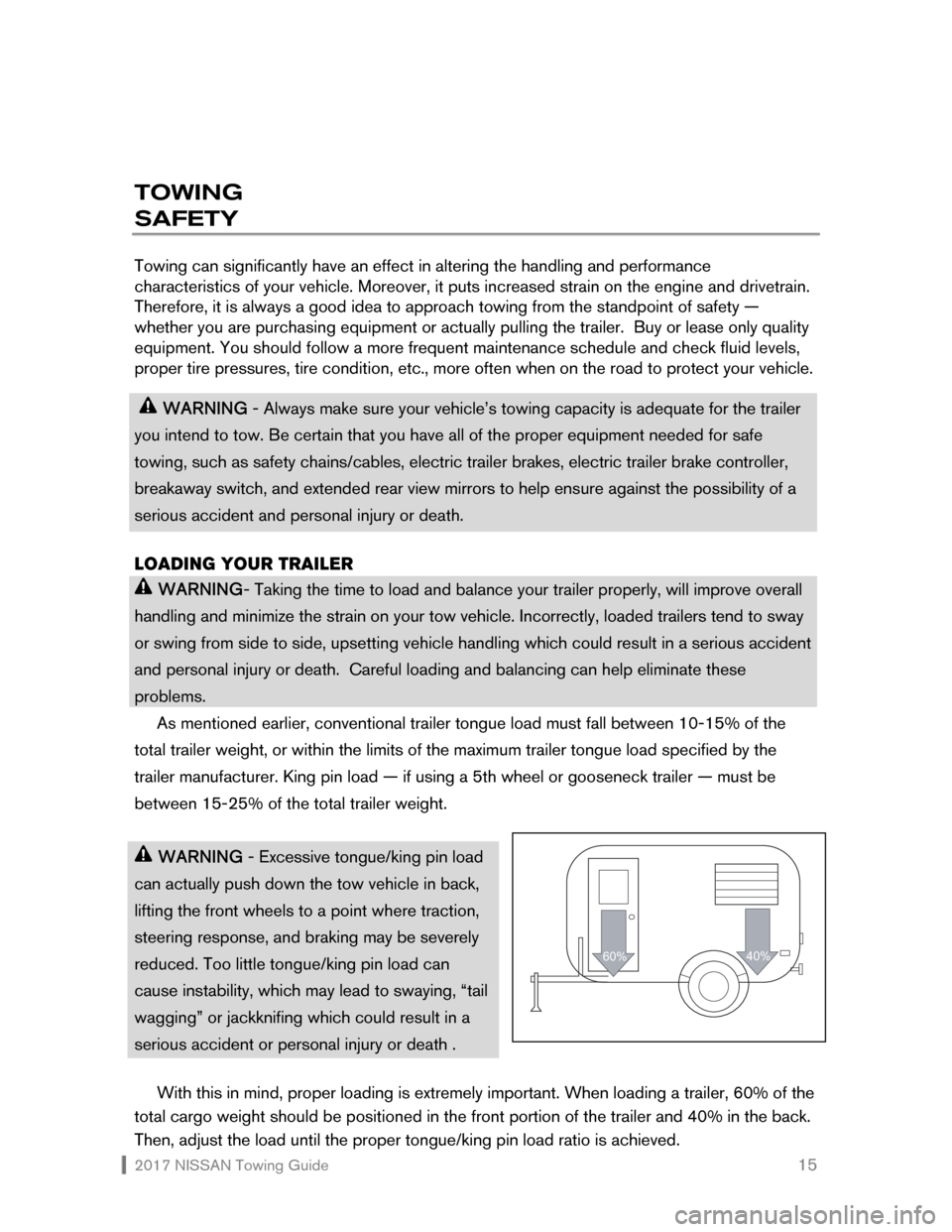
2017 NISSAN Towing Guide 15
TOWING
SAFETY
Towing can significantly have an effect in altering the handling and performance
characteristics of your vehicle. Moreover, it puts increased strain on the engine and drivetrain.
Therefore, it is always a good idea to approach towing from the standpoint of safety —
whether you are purchasing equipment or actually pulling the trailer. Buy or lease only quality
equipment. You should follow a more frequent maintenance schedule and check fluid levels,
proper tire pressures, tire condition, etc., more often when on the road to protect your vehicle.
WARNING - Always make sure your vehicle’s towing capacity is adequate for the trailer
you intend to tow. Be certain that you have all of the proper equipment needed for safe
towing, such as safety chains/cables, electric trailer brakes, electric trailer brake controller,
breakaway switch, and extended rear view mirrors to help ensure against the possibility of a
serious accident and personal injury or death.
LOADING YOUR TRAILER
WARNING- Taking the time to load and balance your trailer properly, will improve overall
handling and minimize the strain on your tow vehicle. Incorrectly, loaded trailers tend to sway
or swing from side to side, upsetting vehicle handling which could result in a serious accident
and personal injury or death. Careful loading and balancing can help eliminate these
problems.
As mentioned earlier, conventional trailer tongue load must fall between 10-15% of the
total trailer weight, or within the limits of the maximum trailer tongue load specified by the
trailer manufacturer. King pin load — if using a 5th wheel or gooseneck trailer — must be
between 15-25% of the total trailer weight.
WARNING - Excessive tongue/king pin load
can actually push down the tow vehicle in back,
lifting the front wheels to a point where traction,
steering response, and braking may be severely
reduced. Too little tongue/king pin load can
cause instability, which may lead to swaying, “tail
wagging” or jackknifing which could result in a
serious accident or personal injury or death .
With this in mind, proper loading is extremely important. When loading a trailer, 60% of the
total cargo weight should be positioned in the front portion of the trailer and 40% in the back.
Then, adjust the load until the proper tongue/king pin load ratio is achieved.
60%40%
Page 17 of 27
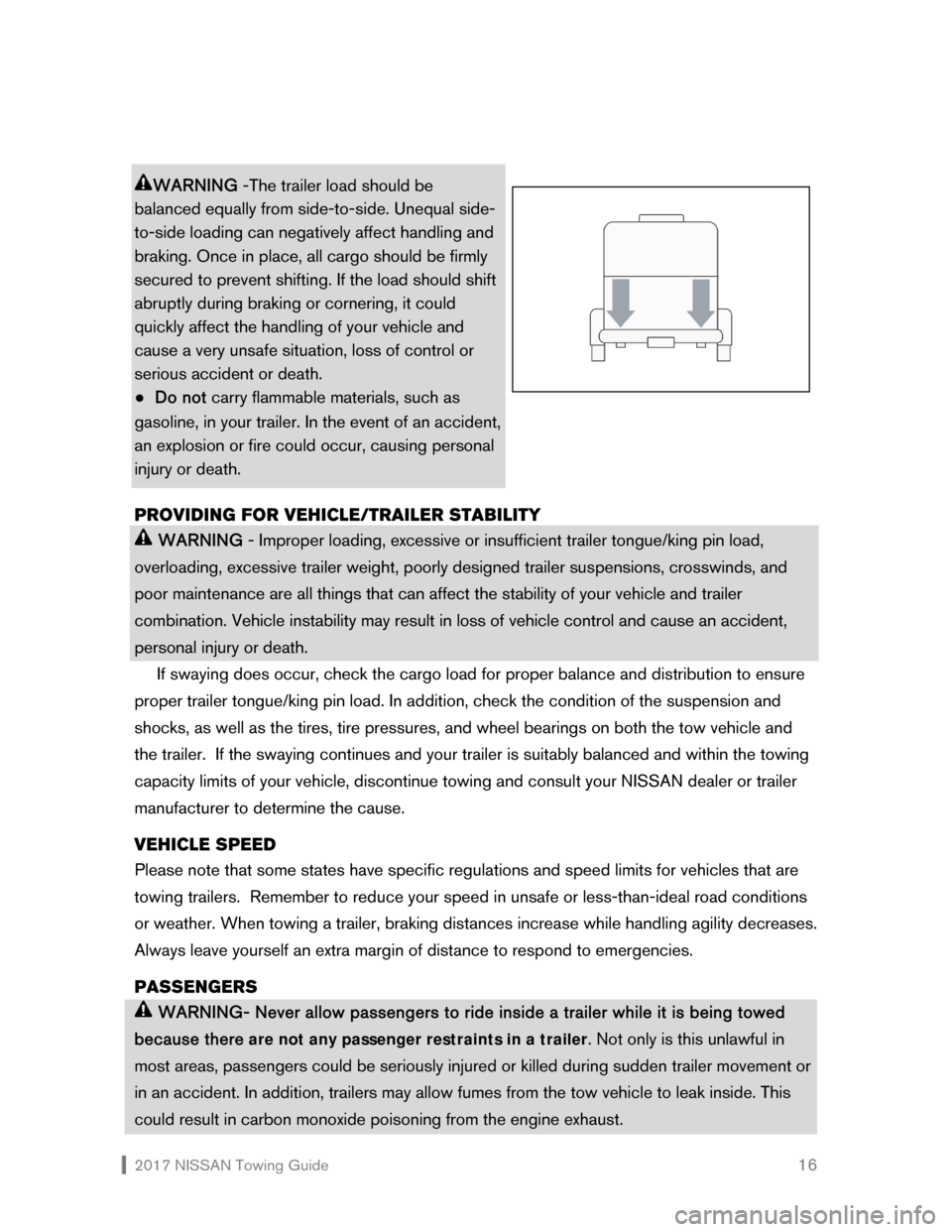
2017 NISSAN Towing Guide 16
WARNING -The trailer load should be
balanced equally from side-to-side. Unequal side-
to-side loading can negatively affect handling and
braking. Once in place, all cargo should be firmly
secured to prevent shifting. If the load should shift
abruptly during braking or cornering, it could
quickly affect the handling of your vehicle and
cause a very unsafe situation, loss of control or
serious accident or death.
● Do not carry flammable materials, such as
gasoline, in your trailer. In the event of an accident,
an explosion or fire could occur, causing personal
injury or death.
PROVIDING FOR VEHICLE/TRAILER STABILITY
WARNING - Improper loading, excessive or insufficient trailer tongue/king pin load,
overloading, excessive trailer weight, poorly designed trailer suspensions, crosswinds, and
poor maintenance are all things that can affect the stability of your vehicle and trailer
combination. Vehicle instability may result in loss of vehicle control and cause an accident,
personal injury or death.
If swaying does occur, check the cargo load for proper balance and distribution to ensure
proper trailer tongue/king pin load. In addition, check the condition of the suspension and
shocks, as well as the tires, tire pressures, and wheel bearings on both the tow vehicle and
the trailer. If the swaying continues and your trailer is suitably balanced and within the towing
capacity limits of your vehicle, discontinue towing and consult your NISSAN dealer or trailer
manufacturer to determine the cause.
VEHICLE SPEED
Please note that some states have specific regulations and speed limits for vehicles that are
towing trailers. Remember to reduce your speed in unsafe or less-than-ideal road conditions
or weather. When towing a trailer, braking distances increase while handling agility decreases.
Always leave yourself an extra margin of distance to respond to emergencies.
PASSENGERS
WARNING- Never allow passengers to ride inside a trailer while it is being towed
because there
are not any passenger restraints in a trailer. Not only is this unlawful in
most areas, passengers could be seriously injured or killed during sudden trailer movement or
in an accident. In addition, trailers may allow fumes from the tow vehicle to leak inside. This
could result in carbon monoxide poisoning from the engine exhaust.